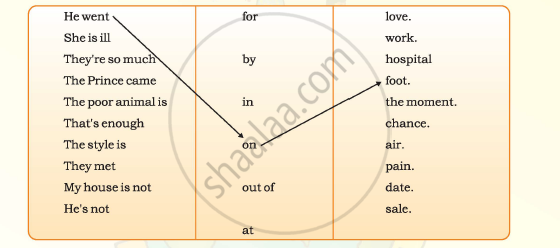Advertisements
Advertisements
Question
Common Combinations using Prepositions
Link the words from the different columns to produce meaningful sentences. One has been completed as an example. If you wish, write out the correct sentences in your notebook.

Solution
He went on foot.
She is ill in hospital (NB : Not ‘at hospital’).
They’re so much in love.
The Prince came by air.
The poor animal is in pain.
That’s enough for / at the moment.
The style is out of date.
They met by chance.
The house is not for sale.
He’s not at work.
APPEARS IN
RELATED QUESTIONS
The ‘Professor’ knew too much. How did he prove himself ? Fill up the space with suitable examples from the story, using the given clues :
(a) about muzzle velocity : _____
(b) after a thirty mile walk : _____
(c) his salute on payday : ______
(d) the loud sound of a high flying invisible aeroplane : _______
(e) about hand grenades : _______
(f) during cook house duties :. _______
Based on your reading of the story, answer the following question by choosing
the correct option.
The narrator says that John was "______ of the suff that heroes are not often lucky
enough to be made of." His tone is sarcastic because __________
Answer the following questions:
‘I make the netted sunbeam dance’. What does ‘the netted sunbeam’ mean? How does it dance?
Identify the rhyme scheme of the poem.
Answer the following question briefly.
Before leaving, the convict asks the Bishop to bless him. What brought about this
change in him?
Present Perfect Continuous
“What have you been doing?”
Imagine what people have been doing or what are the things that have been happening.
| Ashok comes in wearing white shorts, a T-shirt and carrying a racquet. He is sweating. | ||
| I think | he has been playing | tennis |
| I imagine | badminton | |
| Perhaps | badminton | |
(a) Answer the following questions:
- Where were the characters at the time of narration?
- Who was travelling with the aunt?
- How did the children pass their time?
- How long would they take to reach Templecombe?
- How does the aunt respond to the children’s antics? Why do you say so?
(b) You must have used a variety of articles in your answer. Why did you use them? Discuss the reasons with your teacher.
Study the following pair of sentences from the description. Notice the use of
articles-a, an or the or no article (X).
e.g. The next stop was at X Templecombe.
An aunt belonging to the children sat in one corner.
In the corner sat a stranger.
Hence we conclude
1. No article is used before a proper noun.
2. 'The' is used to refer to a specific place/person/ object.
3. 'A' is used when the person/place is referred to for the first time.
4. 'An' is used before a vowel sound.
Will and Shall
Look at this cartoon which shows the difference in the use of present continuous and will to express the future.
It’s Mike’s birthday on January 2nd.

Past passive –
“Where was it made?”
Look at what your partner is wearing. Imagine where the various items of clothing were (or might have been) made, and tell your partner. Use your imagination!
e.g. A : Was your shirt made in France ?
B : No, actually it was made in Brazil.
Adjectives and Prepositions
Look at the table below. Decide which of the adjectives in Column A commonly go with which preposition. Tick the table as shown. (There may be more then one tick for each adjective).
| A | at | to | about | for |
| worried |  |
 |
||
| good | ||||
| bad | ||||
| surprised | ||||
| happy | ||||
| sensitive | ||||
| puzzled | ||||
| married | ||||
| clever | ||||
| suitable | ||||
| curious | ||||
| due | ||||
| qualified | ||||
| famous |
